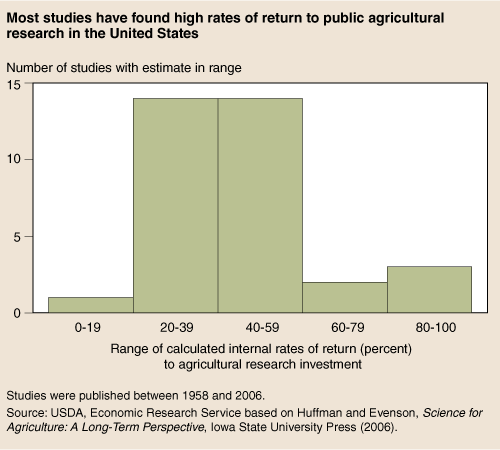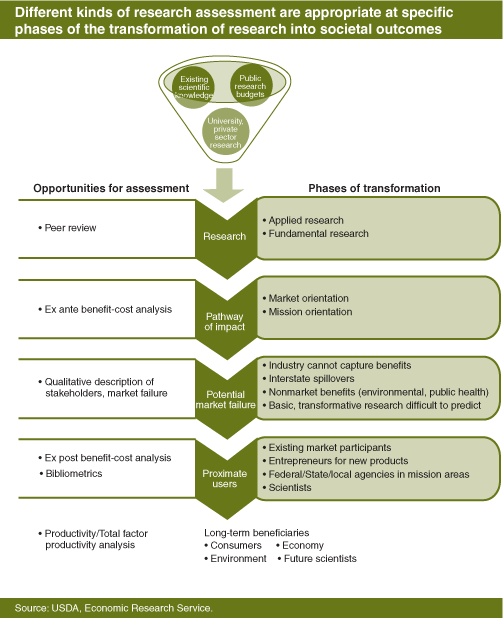Public Research Yields High Returns... Measured in More Than Dollars
- by Paul Heisey, John King and Kelly Day Rubenstein
- 6/16/2011
Highlights
- Well-established quantitative approaches find that in the aggregate, public investments in agricultural research yield high returns and spur growth in agricultural productivity.
- Standard economic approaches may be difficult to apply to evaluations of some research benefits and may not help in gauging important steps necessary to positive research outcomes.
- In these more difficult cases, economic reasoning can provide qualitative analysis even when quantitative estimates of benefits are intractable.
Increased productivity has been the main contributor to economic growth in U.S. agriculture for many years. The U.S. agricultural research system, including Federal, State, and private sector research, has helped drive this growth. Economic analysis consistently finds strong evidence that public investments--Federal and State--in agricultural research and development (R&D) yield high returns per dollar spent, with benefits accruing not only to the farm sector but also to consumers in the form of more abundant food at lower prices.
But clear evidence of the longrun value of agricultural R&D does not always meet the immediate needs of policymakers and agricultural research managers who are responsible for demonstrating continuing social and economic impacts and providing accountability to the taxpayers who fund agricultural research. They need to weigh the expected benefits and costs of particular research projects to prioritize research programs under increasingly tight budgets.
Assessments of the benefits of Federal research programs pose special challenges relative to determining the gains from other Federal programs. The American Reinvestment and Recovery Act of 2009 significantly increased Federal investments in science but also called for the development of new approaches to track resulting economic growth and job creation. Many economic studies that provide the strongest evidence for high returns to public research focus on aggregate data for the entire agricultural sector and analyze the effects of past investments rather than specific effects of current research programs. Data on the inputs and costs of research programs are relatively easy to obtain, but they typically do not include measures of the ultimate effects of research once it leaves the laboratory or research institution.
Even though research payoffs can be very high, they can be hard to attribute to individual research projects. Scientific research builds on previous findings, and related research efforts are often performed concurrently by universities, private firms, and other institutions. Benefits are typically realized after long lags, and adoption or commercialization may occur many years after the initial research was undertaken. Moreover, the measured benefits to the primary users of science and technology arising from Federal research do not include potential indirect benefits to downstream firms, consumers, public health, and the environment.
USDA's Agricultural Research Service (ARS) accounts for the majority of Federal expenditures on agricultural research. ARS employs several methods to assess the quality and impact of its research. Among the most important of these is peer review, which is a structured assessment by experts from the same field of science, generally from outside the projects or programs being evaluated. Peer review is the most common method of Federal research evaluation, and it is widely used throughout the ARS prioritization, planning, and evaluation cycle. The greatest strength of peer review is the assessment of scientific merit of research programs, but it is not always well suited for quantifying market impacts or ultimate social benefits. Benefit-cost analysis is one economic approach that has been used for Federal research programs, but it is most effective for research programs that produce specific, near-market technologies-which miss important parts of the ARS research portfolio. Moreover, a well-done benefit-cost analysis can be time consuming and expensive.
ERS and ARS researchers recently collaborated on a review of available methods for assessing research benefits. Researchers focused on three case studies of ARS research programs: bovine quantitative genetics and genomics; water quality and watersheds; and the measurement, analysis, and widespread publication of the nutritional composition of foods consumed by the U.S. population. These case studies were selected to capture diverse aspects of ARS research, including program scope, coordination roles, and research relevance to USDA missions. They also illustrate the opportunities and shortcomings of existing methods of economic evaluation at the program level.
All of the case studies focused on programs that provide scientific results with few substitutes. Market failures and cross-State applications of research findings may lead the private sector and State-funded institutions to underinvest in economically justifiable research because they cannot expect to capture all the benefits. Most of the benefits in two of the three case studies could not be measured using market prices, and in the third case, there would be significant difficulties in matching demonstrable benefits to particular research cost streams. Because of their 'public goods' nature, the benefits of these ARS research programs would be difficult to replicate by non-Federal research efforts. Qualitative analysis may help to define the public goods characteristics of a research program, may guide other assessment efforts, and may establish the potential for a Federal coordinating role of certain research efforts.
ARS research facilitates numerous linkages between research peers, contributors, and users demonstrated by interviews with stakeholders such as food processors, natural resource managers, and representatives of universities, other Federal agencies, and international research institutions. While it is difficult to estimate the monetary value of such linkages, interest on the part of a diverse group of stakeholders may indicate a broad set of benefits. Bibliometric indicators, such as the frequency with which the research of ARS scientists is cited in other publications (or even patents), may help gauge some of the shorter term benefits of these linkages.
Recent developments in agricultural research pose new challenges for benefits assessments. Formerly, a substantial amount of Federal agricultural research was directed at improving production and input efficiency--goals that often have marketable, quantifiable results. Although production and efficiency remain primary missions of ARS research, newer research areas explore a broader set of goals for agriculture and food production. Research on the reduction of the harmful effects of agriculture on the environment as well as the increase in its beneficial impacts and on the improvement of food safety and human nutrition often contribute both to nonmarket environmental or health benefits and to Government policies and regulations to further those benefits.
Assessing research programs that help the Government fulfill its own functions (sometimes called mission-oriented research) can be especially difficult because the primary users can be policymakers and regulators rather than agricultural producers or consumers. For example, with passage of the Clean Water Act, ARS adapted its soil movement models to examine the effects of sedimentation on downstream water quality. Questions about how research complements other Federal and State efforts to achieve their policy objectives, as well as the ultimate economic impact of policies and regulations, are useful for analyzing the performance of and demand for mission-related research. ARS research, like research by some other Federal agencies, often contributes to the regulatory and policy functions of the Federal Government in ways that other public research institutions do not.
Relationships between research investments and economic and social impacts are often indirect, with complex outcomes shaped by more than one factor, and often attributable to more than one definable research program. These impacts usually occur after considerable time lags. Economic analysis has shown repeatedly that the payoffs to public investment in agricultural research are large, but precise measurements of the economic benefits of particular research programs may remain elusive or be very costly to obtain. Economic reasoning can help to determine if a research program is addressing public goods, if the economic benefits are likely to be substantial, and if the research is addressing other public functions such as providing scientific support to regulatory or policy initiatives even when the calculation of the exact dollar value of the research is not possible.
This article is drawn from:
- Heisey, P., King, J., Day Rubenstein, K., Bucks, D. & Welsh, R. (2010). Assessing the Benefits of Public Research Within an Economic Framework: The Case of USDA's Agricultural Research Service. U.S. Department of Agriculture, Economic Research Service. ERR-95.
- Fuglie, K. & Heisey, P. (2007). Economic Returns to Public Agricultural Research. U.S. Department of Agriculture, Economic Research Service. EB-10.
You may also like:
- Science Under Scarcity: Principles and Practice for Agricultural Research Evaluation and Priority Setting. (1995). Cornell University Press.
- Overview of Evaluation Methods for R&D Programs: A Directory of Evaluation Methods Relevant to Technology Development Programs. (2007). U.S. Department of Energy, Office of Energy Efficiency and Renewable Energy.
- 'Let's Make Science Metrics More Scientific'. (2010). Nature 464. 488-489..



